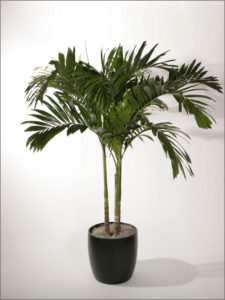
Common Name: Alexander palm
Light Needs
High light
Water Requirements
Water thoroughly
Description:
Formerly known as Adonidia, the Veitchia merrillii tree form palm grows to about 25-feet-tall with eight-foot fronds on a glossy green crown-shaft with a light brown trunk below.
Most commonly used varieties: Normanbya merrillii
Tree form palm grows to about 25 feet tall with eight-foot fronds on a glossy green crown-shaft with a light brown trunk below. New fronds on the Veitchia merrillii are stiff, emerging pointing skyward and opening a dusty, lime-green color, darkening with age in lower light. In the interiorscape, the palm holds only eight to 12 fronds per trunk at any one time, shedding the oldest one as it puts out a new one. As the leaves age, they have the habit of producing uniformly distributed little brown spots, which are almost synonymous with the species.
They must have as much light as possible (a minimum of 200fc) and it must come from over the top of the plant, such as from a skylight.
Veitchia merrillii plants must have plenty of water. The soil must be thoroughly moist, never let them dry out completely. They are big drinkers due to their size. If they stop drinking check for mites! Use Pro-tekt® once per month.
Cleaning palms of dust is a great way to help your palms stay healthy. One way to do this is with a Web-duster, a long-handled tool with a rounded brush on the end that cleans along the main vein of the frond. Also, regularly climb up a ladder or ride a lift to get “up close and personal” with these friendly giants. Hand wipe leaves with long tube socks pulled over your hands and arms. The socks should be dunked into a soapy mix and wrung out to slightly damp. One arm goes on top, the other below each frond, to get both sides clean (and insect free). Also use a Dramm® or electrostatic sprayer for prevention and small outbreaks of insects.
Under good light conditions, Adonidias want regular feedings with a balanced fertilizer. Fertilize twice a year, though newly installed palms won’t need fertilizer for the first year.
Spider mites love these palms (and most others) and can move in and populate seemingly overnight. When palms are stressed (from a move or from a lack of water or humidity) they are especially prone to mite outbreaks.
